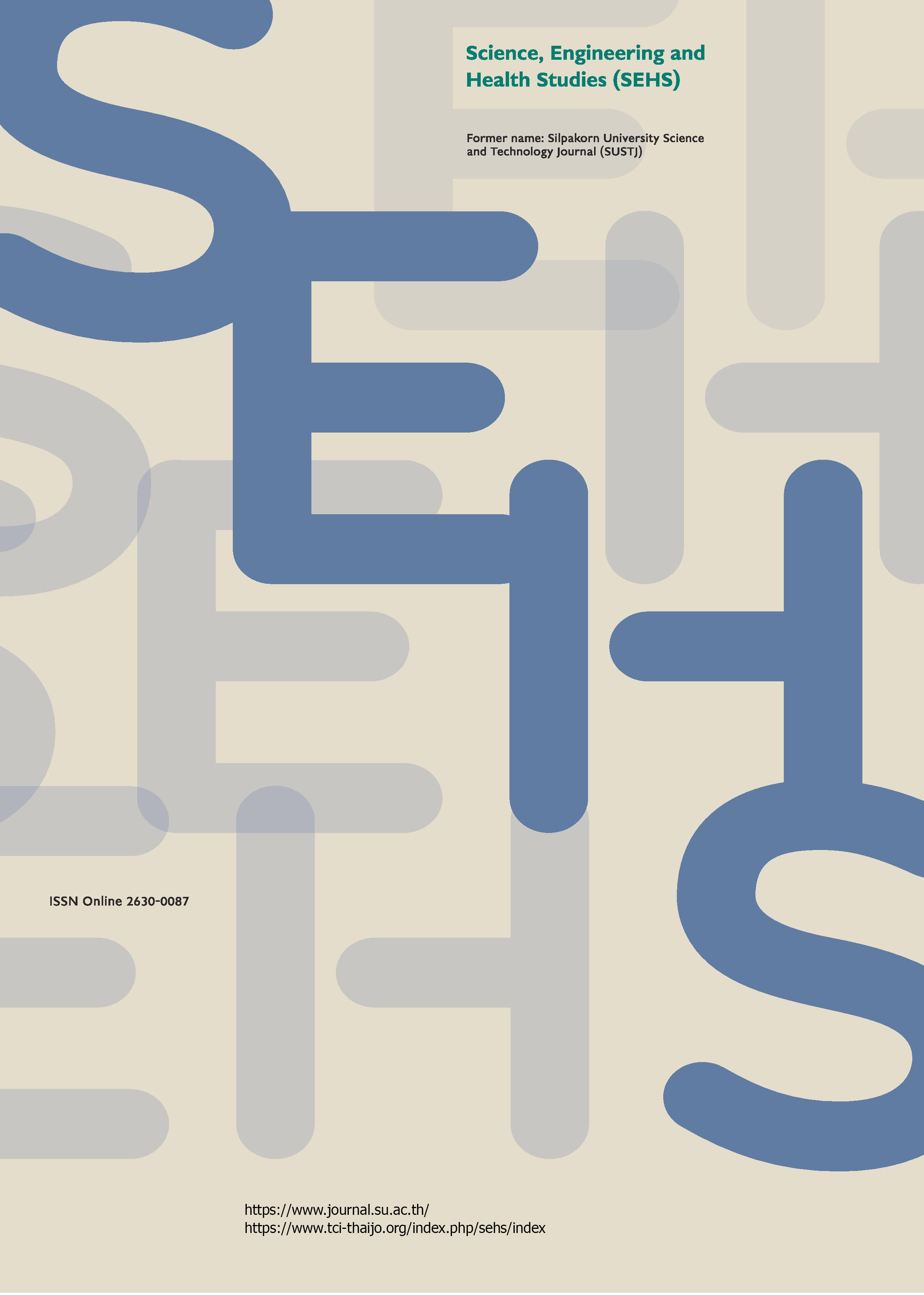Synthesis of trans tert-butyl (5,6-dihydroxycyclohex-3-en-1-yl) carbamate: a potential precursor for (-)-muricatacin derivatives
Main Article Content
Abstract
This study examined the concise synthesis of dihydroxy trans-N-Boc cyclohexene, which could serve as a key starting material for the production of various biologically-active g-butyrolactones, particularly (-)-muricatacin. The synthesis began with meso-monoepoxide cyclohexene and encompassing the catalytic opening of the epoxide ring via the Salen complex that yielded trans-azido cyclohexene, azide reduction, N-Boc protection, and allylic hydroxylation.
Downloads
Article Details

This work is licensed under a Creative Commons Attribution-NonCommercial-NoDerivatives 4.0 International License.
References
Ali, M. T. M., and Aliasak, S. A. (2017a). Short asymmetric synthesis of a model monomeric unit for α/γ peptide foldamers based on β-amino linked D-leucine-cis-γ-butyrolactone γ-acetic acid conjugate. Organic Communications, 10(2), 99-103.
Ali, M. T. M., Zahari, H., Aliasak, A., Lim, S. M., Ramasamy, K., and Macabeo, A. P. G. (2017b). Synthesis, characterization and cytotoxic activity of betulinic acid and Sec-betulinic acid derivatives against human colorectal carcinoma. Oriental Journal of Chemistry, 33(1), 242-248.
Ali, M. T. M., Zahari, H., Aliasak, S. A., and Syed, I. A. S. K. (2018). Synthesis of enantiopure azido trimethylsiloxy cyclohexene derivatives: A useful intermediates for the synthesis of tamiflu. In Bioresources Technology in Sustainable Agriculture (Abdullah, M. F. F., Ali, M. T. B., Yusof, F. Z. M., eds.), 1st, pp. 233-240. Boca Raton, Canada: Apple Academic Press.
Ali, M. T. M., Husin, Z. M., and Macabeo, A. P. G. (2021). Asymmetric synthesis of N,O-heterobicyclic octanes and (−)-Geissman-Waiss lactone. ACS Omega, 6(38), 24614-24618.
Cooze, C., Manchoju, A., and Pansare, S. V. (2017). Synthesis of (–)-muricatacin and (–)-(R, R)-L-factor involving an organocatalytic direct vinylogous aldol reaction. Synlett, 28(20), 2928-2932.
Cortes, D., Myint, S. H., Laurens, A., Hocquemiller, R., Leboeuf, M., and Cavé, A. (1991). Corossolone et corossoline, deux nouvelles γ-lactones mono-tétrahydrofuraniques cytotoxiques. Canadian Journal of Chemistry, 69(1), 8-11.
Doran, R. (2015). Asymmetric Synthesis of Bioactive Lactones and the Development of a Catalytic Asymmetric Synthesis of α-Aryl Ketones, 1st, Dublin, Ireland: Springer, pp. 58-59.
Fernandes, R. A., Gangani, A. J., Kumari, A., and Kumar, P. (2020). A decade of muricatacin synthesis and beyond. European Journal of Organic Chemistry, 2020(44), 6845-6858.
Fletcher, C. J., Wheelhouse, K. M., and Aggarwal, V. K. (2013). Stereoselective total synthesis of (+)‐giganin and its c10 epimer by using late‐stage lithiation-borylation methodology. Angewandte Chemie International Edition, 52(9), 2503-2506.
Ghosal, P., Kumar, V., and Shaw, A. K. (2010). A chiron approach to the total synthesis of cytotoxic (+)-muricatacin and (+)-5-epi-muricatacin from d-ribose. Carbohydrate Research, 345(1), 41-44.
Konno, H., Makabe, H., Hattori, Y., Nosaka, K., and Akaji, K. (2010). Synthesis of solamin type mono-THF acetogenins using cross-metathesis. Tetrahedron, 66(40), 7946-7953.
Kumaraswamy, G., Ramakrishna, D., and Santhakumar, K. (2010). A concise enantioselective total synthesis of (+)-epi-muricatacin, using asymmetric hydrogenation/ intramolecular iodoetherification as key steps. Tetrahedron: Asymmetry, 21(5) 544-548.
Martinez, L. E., Leighton, J. L., Carsten, D. H., and Jacobsen, E. N. (1995). Highly enantioselective ring opening of epoxides catalyzed by (salen)Cr(III) complexes. Journal of the American Chemical Society, 117(21), 5897-5898.
Makabe, H. (2007). Synthesis of annonaceous acetogenins from muricatacin. Bioscience, Biotechnology, and Biochemistry, 71(10), 2367-2374.
Murcia, M. C., Navarro, C., Moreno, A., and Csaky, A. G. (2010). Naturally occurring δ-hydroxy-γ-lactones: muricatacins and related compounds. Current Organic Chemistry, 14(1), 15-47.
Myint, S. H., Cortes, D., Laurens, A., Hocquemiller, R., Lebȩuf, M., Cavé, A., Cotte, J., and Quéro, A. M. (1991). Solamin, a cytotoxic mono-tetrahydrofuranic γ-lactone acetogenin from Annona muricata seeds. Phytochemistry, 30(10), 3335-3338.
Myint, S. H., Laurens, A., Hocquemiller, R., Cavé, A., Davoust, D., and Cortes, D. (1990). Murisolin: a new cytotoxic mono-tetrahydrofuran-γ-lactone from Annona muricata. Heterocycles, 31(5), 861-867.
Ohnishi, K., Sakurai, H., Kobayashi, K., Makabe, H., Teruya, K., Akaji, K., and Hattori, Y. (2015). Syntheses of a pyrrolidine analog of a tetrahydrofuran containing acetogenin, cis-solamin. Heterocycles, 91(3), 573-582.
Perlman, N., and Albeck, A. (2001). Efficient and stereospecific synthesis of (z)-hex-3-enedioic acid, a key intermediate for Gly-Gly cis olefin isostere. Synthetic Communications, 30(24), 4443-4449.
Prasad, R. K., and Gandi, V. (2008). Facile enantiospecific synthesis of (−)-muricatacin. Tetrahedron: Asymmetry, 19(22), 2616-2619.
Somfai, P. (1995). An enantiospecific total synthesis of (+)-muricatacin. Journal of the Chemical Society, Perkin Transactions 1, 7, 817-819.
Sreco, B., Benedekovic, G., Popsavin, M., Hadzic, P., Kojic, V., Bogdanoviv, G., Divjakovic, V., and Popsavin, V. (2011). Heteroannelated (+)-muricatacin mimics: Synthesis, antiproliferative properties and structure-activity relationships. Tetrahedron, 67(48), 9358-9367.
Srinivas, C., Kumar, C. S. S. R., Raju, B., and Rao, V. (2011). An efficient stereoselective approach for the synthesis of (+)‐(4S,5S)‐muricatacin. Helvetica Chimica Acta, 94(4), 669-674.
Tsai, Y. F., Huang, C. C., Lin, S. H., Su, P. M., Chen, Y. J., and Wu, T. Y. (2012). Asymmetric synthesis of (−)-muricatacin’s analogue (4S,5R)-5-hydroxy-4-octadecanolide exhibiting the cytotoxicity against esphageal cancer cells. Heterocycles, 85(2), 299-304.


